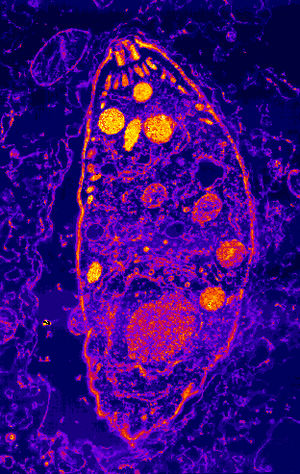Toxoplasmosis and Global Health
Introduction
To start your own paper: Type your page title into the Search box. (Be sure to spell correctly.) Press "Go." The site will offer you the opportunity to "Create this page."
Next, use the "edit" tab to reveal the coded file of BIOL 191 Paper 2009. Select all and copy; paste into the edit window of your own page. (Do not try to edit the class page.)
Introduce the topic of your paper. What public health question do you raise? Whose health is affected; in what country or location? What disease organisms are involved?
Below are some sample codes that will be useful for your paper.
To upload an image: Use "Upload File" (in margin at left)
To make the image appear, you need to embed image insertion code (see sample at right). The insertion code consists of:
Double brackets: [[
Filename: PHIL_1181_lores.jpg
Thumbnail status: |thumb|
Pixel size: |300px|
Placement on page: |right|
Legend/credit: Electron micrograph of the Ebola Zaire virus. This was the first photo ever taken of the virus, on 10/13/1976. By Dr. F.A. Murphy, now at U.C. Davis, then at the CDC.
Closed double brackets: ]]
Other examples:
Bold
Italic
Subscript: H2O
Superscript: Fe3+
There are two parts to the life cycle of Toxoplasma Gondii. The first component is the sexual part of the life cycle, or the Infective Stage. This can only take place in the Felidae family-- a genus composed of wild and domesticated cats. The microbe is consumed by these felines and then survives passage through the stomach. After passing through the stomach, the microbe infects epithelial cells in the small intestine. The microbes undergo sexual reproduction and form oocycsts, the fertilized cyst of a microbe. This oocyst is shed with the feline's feces, where Intermediate hosts in nature such as birds and rodents ingest these contaminated oocysts. In the intermediate host's body, the parasite transforms into a tachyzoite shortly after transmission. A tachyzoite is a mobile, spore-forming parasite that forms tissue cysts. A cat becomes infected with this microbe when it ingests an intermediate host that is harboring these tissue cysts. The disease is spread again when a cat defecates, and other species are exposed.
The asexual part of Toxoplasma Gondii's life cycle begins when another mammal, usually a human, ingests these contaminated feces by various methods. The parasite enters cells in the intestine, is transferred to the blood stream, and is then distributed throughout the body. These microbes can have detrimental, even fatal, affects on certain individuals, and the hardiness of the cyst means that it can withstand many environments and infect various individuals.
Disease Transmission
Include some current research in each section.
Disease Transmission
Include some current research in each section.
Treatment
Include some current research in each section.
Conclusion
Overall paper length should be approximately 2,000 to 2,500 words.
Include at least two data figures.
Use professional sources, including at least two research studies.
References
Edited by student of Joan Slonczewski for BIOL 191 Microbiology, 2009, Kenyon College.

